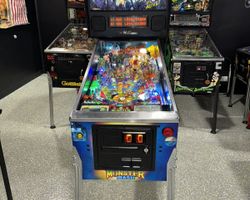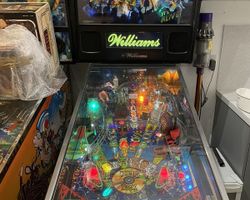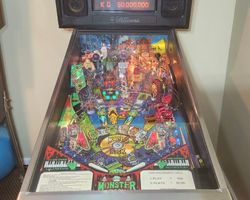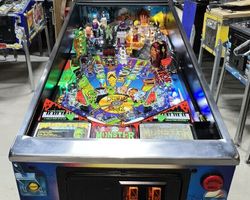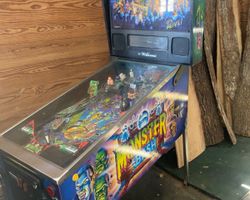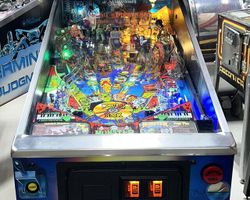Monster Bash
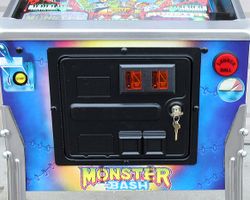
Average Prices: USD $3,400 to $8,200
Produced: July, 1998
Production Run: 3,361 units
Machine Type: Solid State Electronic
MPU: Williams WPC-95
Players: 4
Design by: George Gomez
Art by: Kevin OConnor
Dots/Animation by: Adam Rhine
Mechanics by: Robert C. Friesl, Chris Shipman
Music by: Vince Pontarelli
Sound by: Vince Pontarelli
Software by: Lyman F. Sheats Jr.
Monster Bash, a celebrated pinball machine released in July 1998 by Williams, remains a cornerstone of many collections and a sought-after title on location. Conceived during the peak of the WPC-95 era, this game masterfully blends humor and horror, inviting players into a world where classic Universal Monsters trade screams for rock anthems.
History and Background
Born from the creative minds at Williams Electronic Games, Monster Bash emerged as design lead George Gomez's vision of a monster-themed pinball experience, underpinned by a lighthearted approach. Released in July of 1998, the game quickly captivated players with its unique premise: the iconic Universal Monsters are not terrorizing villagers but forming a rock band.
The artistic direction was helmed by Kevin O'Connor, whose vibrant and cartoonish artwork perfectly complemented the game's comedic tone. Lyman F. Sheats Jr. programmed the intricate software, ensuring smooth gameplay and inventive modes, while Vince Pontarelli composed the memorable music and sound effects, injecting the game with its signature auditory charm. Chris Shipman engineered the mechanical elements, bringing Gomez’s design to life.
Production of Monster Bash reached 3,361 units, a testament to its immediate popularity. Interesting production insights reveal details like black and white test playfields used to verify artwork registration during manufacturing – a behind-the-scenes glimpse into the rigorous quality control processes. An amusing hidden feature, "Lyman's Lament," showcases programmer Lyman Sheats' humorous complaints during development, accessible through a secret flipper code and scoop shot, adding a layer of developer humor to the game.
Signature Features and Design
Monster Bash is instantly recognizable for its playful integration of physical toys and interactive elements. The playfield is populated with custom sculpted figurines representing Frankenstein, The Mummy, Dracula, the Bride of Frankenstein, the Creature from the Black Lagoon, and the Wolfman, each rendered with a cartoonish charm that fits the game's whimsical spirit.
Frankenstein’s Monster is a central figure, mounted on a pivoting operating table that dramatically rises and lowers during gameplay, creating a captivating visual spectacle. Dracula is not confined to a static pose; his figure moves back and forth, adding dynamic life to the playfield. Another notable feature is the “Phantom Flip,” activated by hitting specific targets, which grants game-controlled flipper action when the ball enters an inlane, offering a unique twist to traditional pinball control.
These features are not merely aesthetic additions; they are integral to the gameplay experience. The toys serve as targets, mode triggers, and visual cues, enhancing player engagement and reinforcing the monster band theme.
Playfield and Mechanics
The playfield layout of Monster Bash is both inviting and challenging, characterized by a balanced arrangement of shots and interactive elements. It features three ramps, strategically placed to encourage flow and combo shots. Three pop bumpers add chaotic energy to ball movement, while two slingshots flank the flippers, providing opportunities for skillful nudging and ball control. Eight standup targets and a spinning target offer satisfying shot feedback and are crucial for mode progression. A centrally located scoop serves as a key shot for starting modes and accessing special features. The automatic plunger ensures consistent ball launching, streamlining gameplay.
Kevin O'Connor’s artwork on the playfield is vibrant and detailed, depicting a monster concert stage and surrounding spooky scenery. The color palette is bright and engaging, enhancing the game's lighthearted horror theme. Lighting is carefully integrated to highlight targets, ramps, and toys, creating a dynamic and visually appealing play environment. The overall aesthetic successfully marries the macabre with the comical, creating a unique and immersive atmosphere. The playfield is designed for intuitive flow, guiding players through sequences of shots that build towards satisfying gameplay loops and multiball events.
Gameplay Dynamics
Monster Bash’s gameplay centers around the concept of assembling a monster rock band. Players must "bash" each monster – Frankenstein, Dracula, Wolfman, Creature, Mummy, and Bride – by hitting specific targets and completing associated tasks to recruit them into the band. Each monster has its own mode, initiated by hitting the scoop after enabling the respective monster.
The game offers a four-ball multiball, a staple of exciting pinball action, enhancing scoring opportunities and chaos on the playfield. Progression is achieved by completing monster modes, ultimately leading to the "Monsters of Rock" wizard mode, the pinnacle of the game. This mode is reached after all six monsters have been recruited and their individual modes played, offering a final, high-energy challenge.
Gameplay is characterized by its accessible ruleset while still offering depth for experienced players. Strategies often involve prioritizing monster recruitment and efficient mode completion to reach "Monsters of Rock." The game's humorous callouts, delivered by the monsters themselves, add to the engaging and memorable experience. Dracula might taunt "Can you hit dis bat with dat ball?" and other lines that inject personality into the gameplay.
Reception and Legacy
Monster Bash is widely regarded as a classic pinball machine, celebrated for its engaging gameplay, charming theme, and high production quality. Player feedback consistently praises its accessible yet deep ruleset, making it enjoyable for both casual players and seasoned enthusiasts. The whimsical monster theme and vibrant artwork resonate strongly, contributing to its enduring appeal. The sound design, characterized by humorous voice-overs and thematic music, is also frequently lauded as a key component of the game's immersive experience.
While overwhelmingly positive, some feedback points to potential areas for critique. Some experienced players find the game’s difficulty level relatively low, leading to concerns about long-term replayability once major game objectives are consistently achieved. A few players have noted that the playfield can appear somewhat dark in certain lighting conditions. Additionally, a minority of players express a preference for a more traditional horror theme, finding the rock band twist slightly less appealing. Despite these minor points, the consensus firmly places Monster Bash among the upper echelon of pinball machines.
Monster Bash's legacy is solidified as a high point of the WPC-95 era and a benchmark for themed pinball design. Its lasting popularity is evident in its continued presence in collections and on location, demonstrating its timeless appeal within the pinball community. It remains a testament to clever design, engaging gameplay, and a theme executed with both humor and heart.
 Active Auctions
Active Auctions
 Auction Results
Auction Results
| Cost | Location | Date |
|---|---|---|
| USD $9,999 |  California, United States California, United States |
04 October, 2024 |
| USD $12,000 |  Arizona, United States Arizona, United States |
31 January, 2024 |
| USD $8,800 |  Texas, United States Texas, United States |
19 December, 2023 |
| USD $9,750 |  New York, United States New York, United States |
08 October, 2023 |
| USD $11,999 |  California, United States California, United States |
16 July, 2023 |
| USD $9,900 |  United States United States |
12 April, 2023 |
| GBP £8,000 |  Stafford, United Kingdom Stafford, United Kingdom |
24 March, 2023 |
| USD $11,999 |  California, United States California, United States |
13 February, 2023 |
| USD $8,500 |  Georgia, United States Georgia, United States |
27 January, 2023 |
| USD $9,000 |  Ohio, United States Ohio, United States |
29 September, 2021 |


Private Policy · Search Website · Contact Us
All trademarks and copyrighted materials remain property of their respective owners.
All other content copyright 2007 - 2025 Pinpedia.

